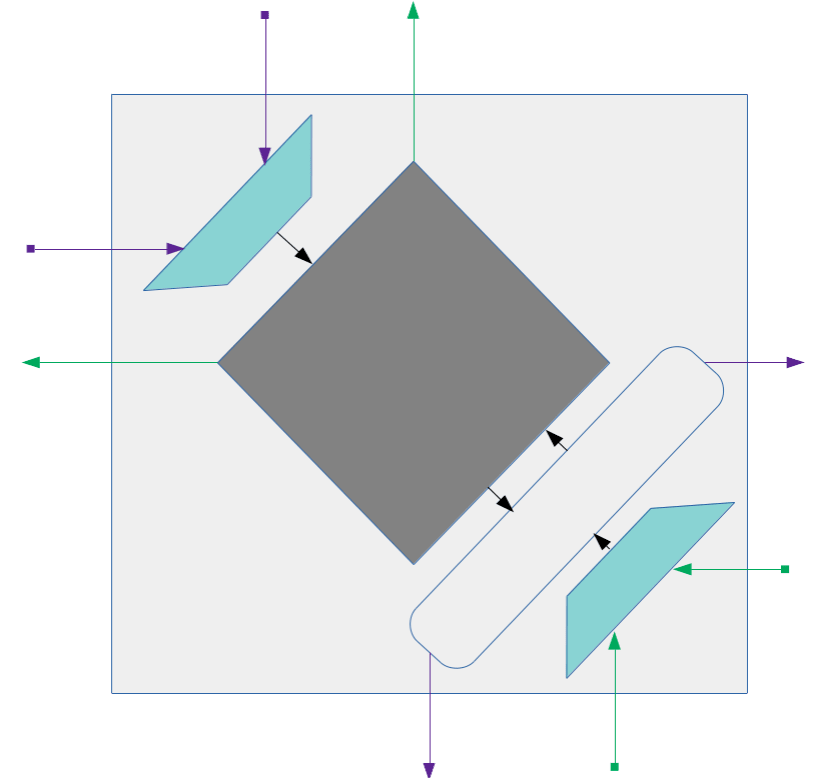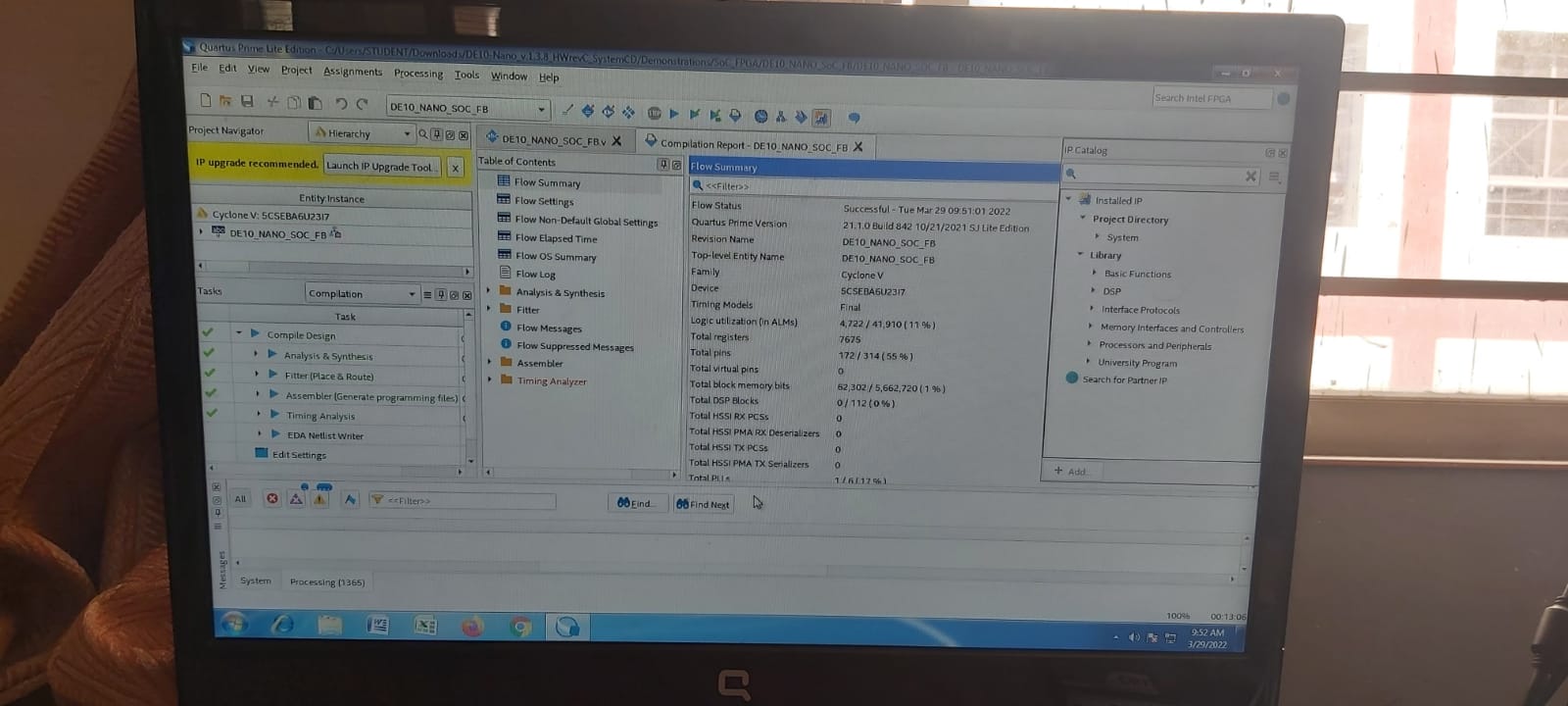 Data Management
Data Management
R2A2: Runtime Reconfigurable Application Accelerator
AP121 »
With Moore's Law at its limits, one way of increasing compute capacity is Application Specific Hardware Acceleration; whereby a compute intensive problem is off-loaded to an Application Specific Processor - often called an ASIC - that leverages a specialized data-path to solve the problem much faster than a General Purpose Processor. (Examples are GPUs, Broadband Processors, AI acceleration chips etc.) Problem is, there can only be so many ASICs on a device deployed on edge. Also, ASICs are expensive to produce, and by nature, not reconfigurable.
The Goal of this project is to find a compromise between the expedient, but inflexible ASIC; and the versatile, but slow GPP. The R2A2 will use the Cyclone-V SoC, to realize a general-purpose, single-board, edge-deployable computer, which will run various compute intensive tasks of different resource load requirements. Depending upon the application running at a time, the R2A2 will configure the FPGA component of the Cyclone V SoC to act as an accelerator. This accelerator will be seen by Linux running on the SoC's ARM processor as a separate device, and a corresponding device driver, also loaded on the runtime will interface between the Processor and the FPGA.
By introducing runtime reconfigurable application-specific hardware, the R2A2 will help reduce carbon footprint by reducing global ASIC production requirements: This will eliminate potential e-waste down the years, while still providing high performance per-watt, which is desirable for computing on the edge. Also, high compute power on edge will lift bandwidth strain from the cloud/IoT infrastructure and reduce latency between the systems. Ideally, R2A2 will serve as a prototype for a plethora of Edge/IoT solutions utilizing FPGAs on SoCs for low cost, high flexibility, application specific operations.
 Water Related
Water Related
IOT based Smart Agriculture
AP122 »
The Continuously increasing demand of the food necessitates the rapid improvement in food production technology. In most of the developing countries, the national economy mainly depends on the Agriculture. But these countries do not able to make proper use of agricultural resources due to the high dependency on rain. Nowadays different irrigation systems are used to reduce the dependency of the rain and mostly the existing irrigation systems are driven by electrical power and manually ON or OFF scheduling controlled. The proposed system is usually designed for ensuring the proper level of water for growing up the plants all through the season. In addition, it provides maximum water usage efficiency by monitoring soil moistures at optimum level and it saves the electrical energy by turning off the motor when there is no water in the pump. The traditional methods are not efficient in controlling the illegal entry and it requires more labour work and time etc.
 Smart City
Smart City
Dumpyard Gas Monitoring System (DuGaMoS)
AP123 »
Existence of Toxic gases in huge dump yards and landfills has become a major concern in urban pockets. It leads to a lot of health issues, environment pollution and overall ecosystem damage. In order to address this problem we have come up with a solution of identifying or detecting the prevalence of toxic gases in these landfills. We propose to identify poisonous gases like Methane, Hydrogen Sulphide, Carbon Monoxide, Ammonia etc through an array of gas sensors integrated with Intel FPGA as the processor. Our target segment will be huge landfills and dump yards. We prefer to use Intel FPGA due to its parallel processing capabilities, extendable interfaces with several I/O ports, and high performance computing facility even with complex algorithms.
 Other: Agriculture
Other: Agriculture
Soil and Plant health monitoring through Smart Sensing and Monitoring System
AP124 »
Nowadays the major problems in Indian agriculture are small holdings, depleted soil and lack of easily driven systems to improve the yield at a large scale. In order to provide remedy for this issue,there is a need of a system which is easily accessible to monitor their plant health by providing data for their field conditions, humidity, pH level, water salinity and provide use full data about their plant. With the advent of recent developments in sensor technology and Embedded systems, its is possible to monitor the soil parameters and plant health. This research aims at providing assistance to the farmers for smart farming by developing smart IoT based real time systems for soil sensing and plant health monitoring. This proposed system measures the level of macro-nutrients present in the soil by using real time on the go technique. Further measured parameters are communicated to farmers in order to take decisions on water management, fertilizer utilization, crop selection and cultivation. In order to monitor the plant health ,the proposed system incorporates real time image acquisition and image processing techniques to detect the abnormalities on the surface of the leaves.
 Smart City
Smart City
Efficient method for automatic detection of door through sobel edge detector using fpga
AP126 »
Image Processing in its general form pertains to the alteration and analysis of pictorial information. The objective of image processing is to visually enhance or statistically evaluate some aspect of an Image not readily apparent in its original form. This processing is used for convenience in order to reduce the complexity faced during the operations performed on an image. Edge detection is one such branch of image processing used to detect the edges of the objects in a picture by calculation the difference in brightness of that edge pixel with its surrounding pixels using gradient method. In this project, Sobel operator is used as a filter for detection of edges of projection of a door without further increasing the already complex process of image processing. This is done using MATLAB, Sobel filter and FPGA.
 Industrial
Industrial
SoC design for enhanced keyword spotting applications with eliminated resources
EM042 »
It is aimed to deploy a combined Machine Learning (ML) system based on both FPGA and HPS units of DE10-Nano platform that will be enhancing the capabilities of a keyword spotting (KWS) application. The KWS will be executing at HPS as a low power application targeting limited resources requirements. Together, the required peripherals, such as the microphone input will be handled. The design in the FPGA will be incorporating neural network (NN) models, responsible to enhance the quality of the speech signal by removing environmental noise. Hence, features extraction will be more accurate and the demands in KWS application can be eliminated to reach low power, low size implementation without compromising the performance of the detection.
 Other: Renewable energy applications
Other: Renewable energy applications
IoT oriented Battery Management System (BMS) for real-time and accurate Battery State and Health Monitoring targeting renewable energy applications
AP133 »
A Robust Battery Management System (BMS) for real-time and accurate Battery State and Health Monitoring is the most critical subsystem of any application which uses Battery Energy Storage Systems (BESS). The accurate monitoring of battery parameters is important to prevent any unforeseen catastrophic situation. We have proposed state-of-the-art Battery monitoring algorithms for estimating the State-of-Charge, State-of-Health, State-of-Power, and State-of-Function of Li-Ion Batteries.
The BMS algorithms will be developed on Intel FPGA and include functionalities such as overcharge, undercharge, and overcurrent protection circuits as well as Automatic cell balancing and uploading the data to the cloud. Such a novel design provides a power-efficient as well as a high-speed solution for the highly complex BMS.
 Food Related
Food Related
Food Saver
EM044 »
Food Saver aims to reduce food waste in resorts and hotels by preventing overproduction and improving storage and service conditions.
 Water Related
Water Related
Monitoring and Predicting Urban Water Reservoirs
AP135 »
Water scarcity is a global crisis which is faced by many countries across the world. It is one of the most serious risk faced by the world at different sector(social, economic, political and environmental). Around 1.2 billion people, or almost one-fifth of the world's population, live in areas of water scarcity, and 500 million people are approaching this situation. Another 1.6 billion people, or almost one quarter of the world's population, face economic water shortage (where countries lack the necessary infrastructure to take water from rivers and aquifers).
 Other: Biodiversity
Other: Biodiversity
SGP: AIoT based platform for snow leopard tracking
EM045 »
The goal of this project is to develop an AIoT based platform to detect and track snow leopards in Sanjiangyuan region, China.
 Health
Health
Smart Health Care Monitoring Unit for Bed Ridden Patients
AP139 »
A comfortable health monitoring unit which is wearable for
patients is presented .The unit is based on a wearable interface
implemented by temperature sensor, pulse detector, ammonia gas
sensor and accelerometer.
This unit works with existing devices including above mentioned
sensors. They are attached to patients cloth that transmits data in
wireless medium to central monitor.
To continuously monitor the health care aspects such as body
temperature, odour of NH3 gas , activity movement and location
of bed ridden patients.
 Smart City
Smart City
Blending Tech with TEK
AS047 »
As we move forward into a post-climate-change future, temperature regulation proves to be increasingly important for human survival and comfort, which makes up a significant portion of a building’s energy consumption. As such, our project focuses on improving the energy efficiency of temperature regulation in buildings through the use of Traditional Ecological Knowledge and smart-home design (with the help of the Azure cloud).
Ventilation, cooling, and heating account for 33% of energy use in U.S. commercial buildings, which relies upon conventional systems of cooling down air via refrigerants and pushing the air into rooms. However, there are different methods of cooling that utilize more passive properties of airflow. The Eastgate Centre in Zimbabwe is the biggest example of this.
The Eastgate Centre was designed with biomimicry in mind, to emulate the ability of termites to cool down and ventilate their nests while using less energy than conventional systems. It succeeds in this: despite still using high-powered fans, the Eastgate Centre uses only 10% of the energy compared to similarly-sized buildings using air conditioning, and uses 65% of the energy while actively cooling.
However, the Eastgate Centre’s design leaves some room for improvement, such as the usage of fans. Termites are able to do what they do by selectively opening and closing vents in the nest to maximize the flow of cool air. Our project improves upon the Eastgate design by more closely imitating the termite model and utilizing an FPGA-run system that uses actuator-operated windows to control airflow and further reduce energy consumption. It can accomplish this by sensing the temperature outside and inside of the building at the actuator locations, and opening and closing the windows accordingly. By opening the windows when it is cooler outside, the building takes advantage of cross-ventilation to passively draw in cool air without the use of fans. It will not be the same temperature on every side of the building; thus, the system opens the windows only at the specific sensor, and keeps it closed on the hotter sides.
An additional problem with both conventional AC and with the Eastgate Centre design is that they are reactive rather than predictive systems. Our design connects to the Azure cloud to obtain weather forecasts, which it then uses to pre-cool the building. This not only means the cooling system doesn’t work as hard during a specific period of time, but this also helps reduce energy use during an electric grid’s peak hours. It is also easier for the system to cool the building while it is still relatively cool than to do so when it has already become hot.
Overall, our system improves upon previous designs to reduce energy consumption when cooling buildings in three ways: by utilizing passive cross-ventilation as a cooling method, by taking into account the weather forecast, and by using the FPGA to monitor and manage all of these components together. By using an embedded system (the FPGA and the cloud) we are able to create a more proactive and energy efficient system than conventional AC systems.